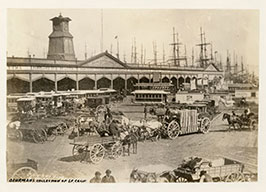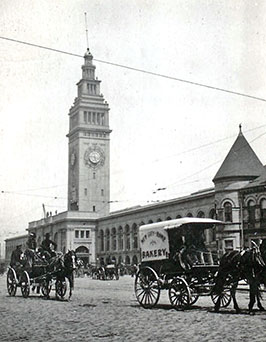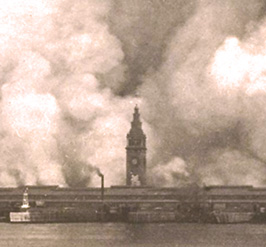San Francisco Landmarks
Ferry Building
Embarcadero at Market Street
Built 1898
Statement of Significance
Although other buildings lay claim to greater age and/or architectural integrity, the most readily identifiable building in San Francisco - either by location or architectural form - is the venerable Ferry Building. During its history, it has been viewed and used by more people than any other building in the history of the city.
From City Planning Commission Resolution dated February 10, 1977.

Construction of the Ferry Building was authorized by the electorate of California in November 1892 for construction of a Union Ferry Depot in San Francisco. The building was designed by A. Page Brown who died shortly after contracts for its construction were let on December 26, 1895.
On July 13, 1898, the building opened for public use. It had been built according to Brown's design; however, its length had been shortened from 840 feet to 659 feet. With this diminution in size, the intended monumental entrances at both ends, facing Market Street and similar to the main entrance at the base of the tower, were not erected. At the time, it was assumed that the building would be lengthened when the need for more ferry slips arose.
The building's most prominent feature was the much discussed tower rising 235 feet and visible for much of the length of Market Street. It was noted with pride that the tower was modeled after the Giralda of the Cathedral of Seville and that there was only one other like it in the United States - that at Madison Square Garden (the original 1890 Garden) in New York. The Garden was designed by McKim, Mead, and White, in which firm A. Page Brown had been employed prior to his coming to San Francisco.
The clock faces on the tower were the largest in the United States at the time. They were 22 feet in diameter, with an eleven-foot minute hand and a seven and one-half-foot hour hand whose seven-day mechanism was powered by a 900 pound weight. For some time the clock was the subject of much derision for, dependent on the direction of strong winds and the face of the clock, it would gain or lose time - as much as 15 minutes in an hour.
Surmounting the tower was a flagstaff with a time ball four-feet in diameter. Until completion of the Ferry Building, the time ball had been located at the observatory on Telegraph Hill where every day at noon it dropped the length of the pole; this operation was observed by ships and their chronometers were checked for accuracy. Originally gilded for the Ferry Building, the ball was soon painted black because there was a problem of seeing the gold against the bright sky. (The ball remained in operation at this location until it was moved to the Fairmont Hotel in 1909. It ceased operating there on June 30, 1937.)

The Ferry Building is also National Register Listing #78000760.



